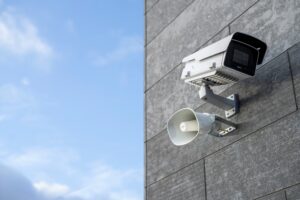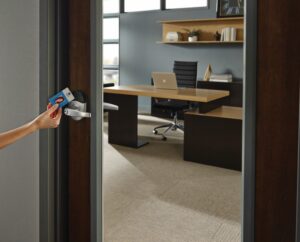Understanding the Full Spectrum of Security Infrastructure

In today’s environment, safeguarding schools and public facilities demands a comprehensive approach. Security directors, facilities managers, and school leaders must coordinate multiple technologies such as lockdown systems, video surveillance, access control, intrusion alarms, and unified platforms to protect people effectively. This Article explores each layer of modern security infrastructure, drawing on industry standards and best practices to offer actionable guidance. While the focus is on K-12 schools, these principles also apply to hospitals, higher education campuses, and commercial enterprises.
What Is a Security Infrastructure?
Security infrastructure includes the systems, software, hardware, and protocols that protect people and property. It spans physical tools like cameras and access control readers, along with digital elements such as centralized management platforms, mobile alerts, and analytics. A full-spectrum approach means integrating these tools for proactive prevention rather than reactive response.
Why Integration Matters
A camera might show who entered a door, but without access control, it can’t stop them. An alarm might notify you of an intrusion, but without video, there’s no context. Integration allows your systems to work together—automatically locking doors during a lockdown, surfacing relevant video feeds, and triggering intercom announcements. This speed and coordination are essential in schools, hospitals, and large campuses.
In a K-12 environment, a lockdown trigger can activate multiple systems at once: classroom doors lock, audio announcements play, camera feeds display in the security operations center, and alerts go out to first responders. The Partner Alliance for Safer Schools (PASS) recommends enabling remote lockdown from staff devices and ensuring that all locking mechanisms comply with NFPA 3000 egress requirements (NFPA 3000, PASS Guidelines).
Core Components
Lockdown Systems
Lockdown systems are designed to secure buildings or zones quickly in emergencies. Integration with access control, intercoms, public announcement systems, signage, and surveillance enables rapid coordination. Activation methods include fixed panic buttons, wireless buttons, mobile apps, or silent alarms like a double swipe of a card reader.
PASS recommends that remote lockdown capabilities be distributed across multiple roles and not rely on a single administrator. Some schools also enable lockdown activation via mobile devices or tablets, providing staff the ability to respond regardless of their location.
Lockdown systems must comply with life safety codes. According to NFPA 3000, doors must permit free egress with a single motion to avoid trapping occupants. Schools should conduct lockdown drills at least twice a year and review emergency procedures with faculty regularly.
A robust lockdown solution is tied to a central station monitoring service that can instantly escalate emergencies to local law enforcement. When combined with intercom messaging and automated voice alerts, it ensures everyone on campus receives timely and accurate instructions.
Video Surveillance
High-resolution IP cameras, such as the Axis Q series, support features like IR visibility, wide dynamic range, and on-camera analytics. Proper camera placement is essential to reduce blind spots and protect privacy. Schools should standardize camera models for easier maintenance and consistent training.
Video analytics can detect motion, loitering, or line crossing, and send automated alerts. Surveillance systems must include a defined retention policy, typically 30 to 90 days, backed by audit logs and access control to prevent unauthorized review.
Video Management Systems (e.g., Milestone XProtect)
A VMS connects, organizes, and retrieves footage from all cameras. With platforms like Milestone XProtect, security teams can view live video, access archived footage, and receive automatic alerts when integrated systems detect threats.
Features like role-based permissions, audit trails, and event tagging help districts stay compliant and investigate incidents more efficiently. Integration with access control and alarms allows video feeds to react dynamically when a door is breached or a panic button is pressed.

Access Control (LenelS2, HID, Cloud)
Access control regulates who can enter what areas and when. Outdated proximity cards using 125kHz technology are vulnerable to cloning. Modern credentials such as HID iCLASS SEOS or MIFARE DESFire provide encrypted authentication, and mobile credentials add further flexibility.
Open Supervised Device Protocol (OSDP), published by SIA and now an IEC standard, offers encrypted two-way communication between card readers and controllers (SIA OSDP). This protects against spoofing and supports advanced features like tamper detection.
Access systems should trigger surveillance feeds when unauthorized access occurs, enforce after-hours restrictions, and be reviewed regularly for proper permissions.
Intrusion Detection (Bosch)
Intrusion systems guard facilities during off-hours using motion detectors, door/window sensors, and glass-break detectors. Bosch panels offer reliable performance and zoning features for partitioned spaces.
Reducing false alarms is critical. This includes using dual-technology sensors, ensuring correct installation, and performing regular system tests. Integration with unified platforms allows alarms to surface relevant video, notify administrators, and support faster verification.
Unified Platforms (Genetec Security Center)
Unified security platforms such as Genetec Security Center consolidate multiple systems—video, access, alarms, intercoms, and license plate recognition—into a single dashboard (Genetec Security Center).
These platforms allow real-time coordination. For example, when a door is forced open, the system can instantly display the nearest camera, generate an alert, and send a notification to an administrator’s phone. Map-based views, automated workflows, and AI-powered search tools allow operators to respond quickly and efficiently.
Unified systems also support district-wide scalability, centralizing monitoring for multiple schools while enabling local autonomy. Many also include integration with intercoms, public address systems, and SIP devices, allowing campus-wide communication during emergencies.
Standards and Best Practices
Following nationally recognized standards ensures that security infrastructure is not only functional but also interoperable, scalable, and resilient.
- NFPA 3000: Offers guidance for preparing for and responding to active shooter or hostile events. Emphasizes coordinated emergency actions, life safety, and communications during lockdowns.
- SIA OSDP: Replaces unencrypted legacy wiring in access control with secure, tamper-resistant communication. Adopted as IEC 60839-11-5 for international use.
- NIST SP 800-53: Federal security controls for both physical and digital systems. Relevant to video, access, alarms, and audit processes (NIST 800-53).
- PASS Guidelines: Offers tiered recommendations for K-12 campuses, promoting standardization, interoperability, and strong incident response practices (PASS Guidelines).
- Manufacturer Best Practices: Refer to Axis, Milestone, Bosch, HID, and Genetec for design and cybersecurity guides, firmware updates, and integration manuals.
Conclusion
Creating a safe environment requires more than cameras or locks. It takes coordination, planning, and training. Standards like NFPA 3000 and NIST 800-53 offer a framework for preparedness. Unified platforms help streamline operations and integrate tools across sites. And lockdown capabilities, if well-integrated, can make the difference between confusion and coordinated action.
Security should empower educators, healthcare workers, and administrators to do their jobs without worry. A layered system with surveillance, access control, alarms, and communication– integrated through a unified platform, ensures that your infrastructure supports not just response, but prevention and resilience.
True safety comes from systems working together, reinforced by drills, clear policies, and trusted support partners. Whether you’re designing a new system or upgrading your existing one, take a full-spectrum view. Your investment will not only reduce risk but build confidence among staff, students, and the community.
If you’re exploring options or need guidance, the team at Digital Provisions is here to help. We specialize in tailored security infrastructure for schools and institutions across Long Island and the Tri-State Area. Contact us today to get started.
